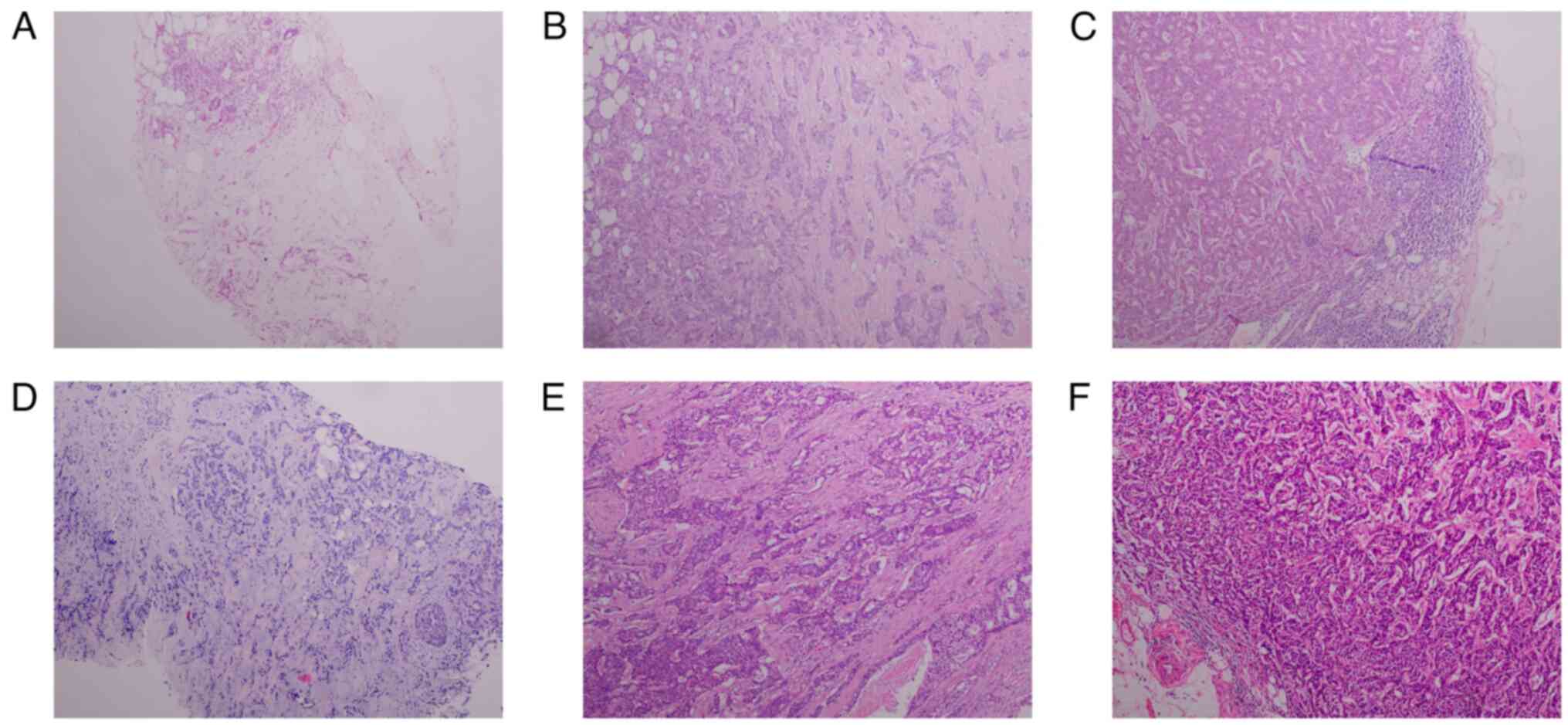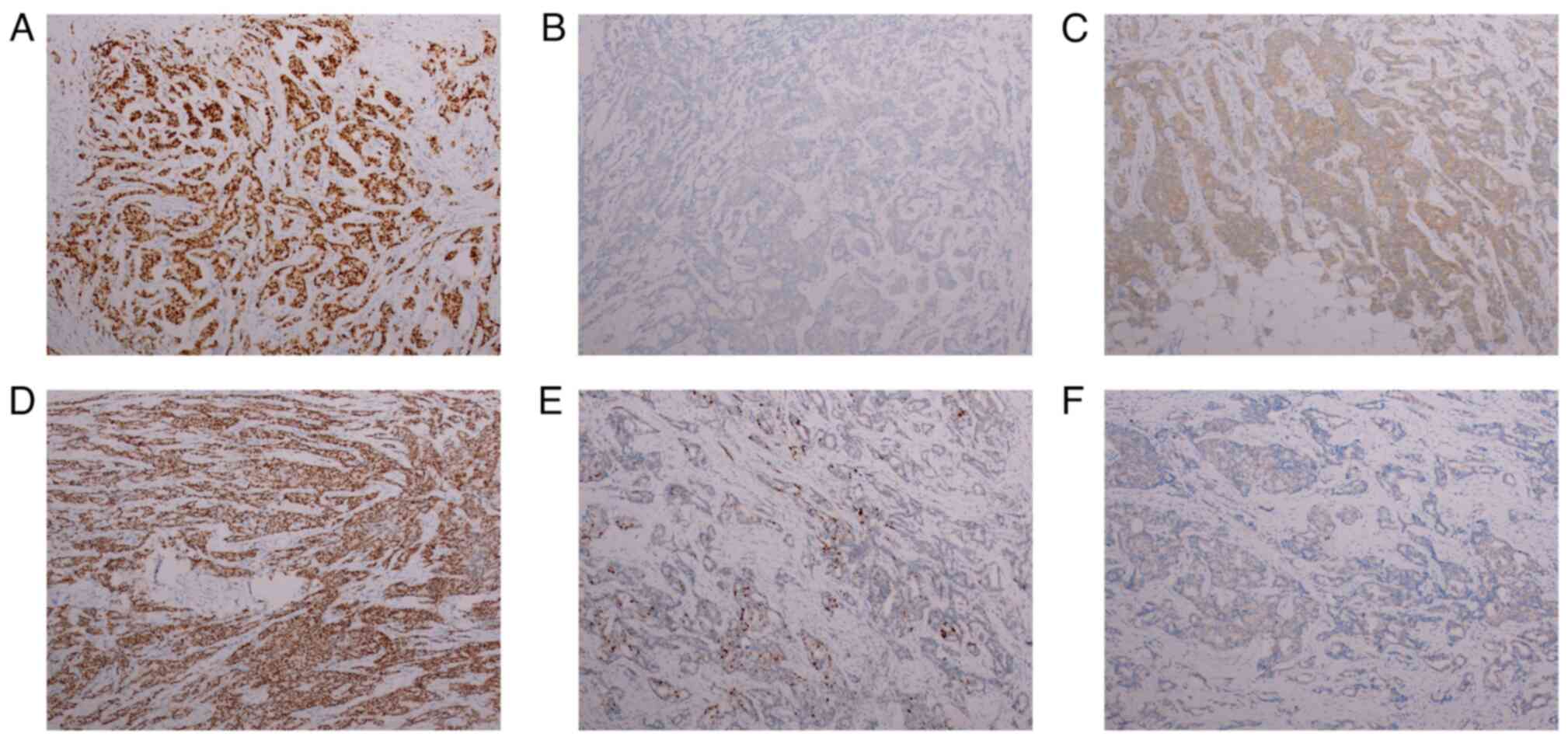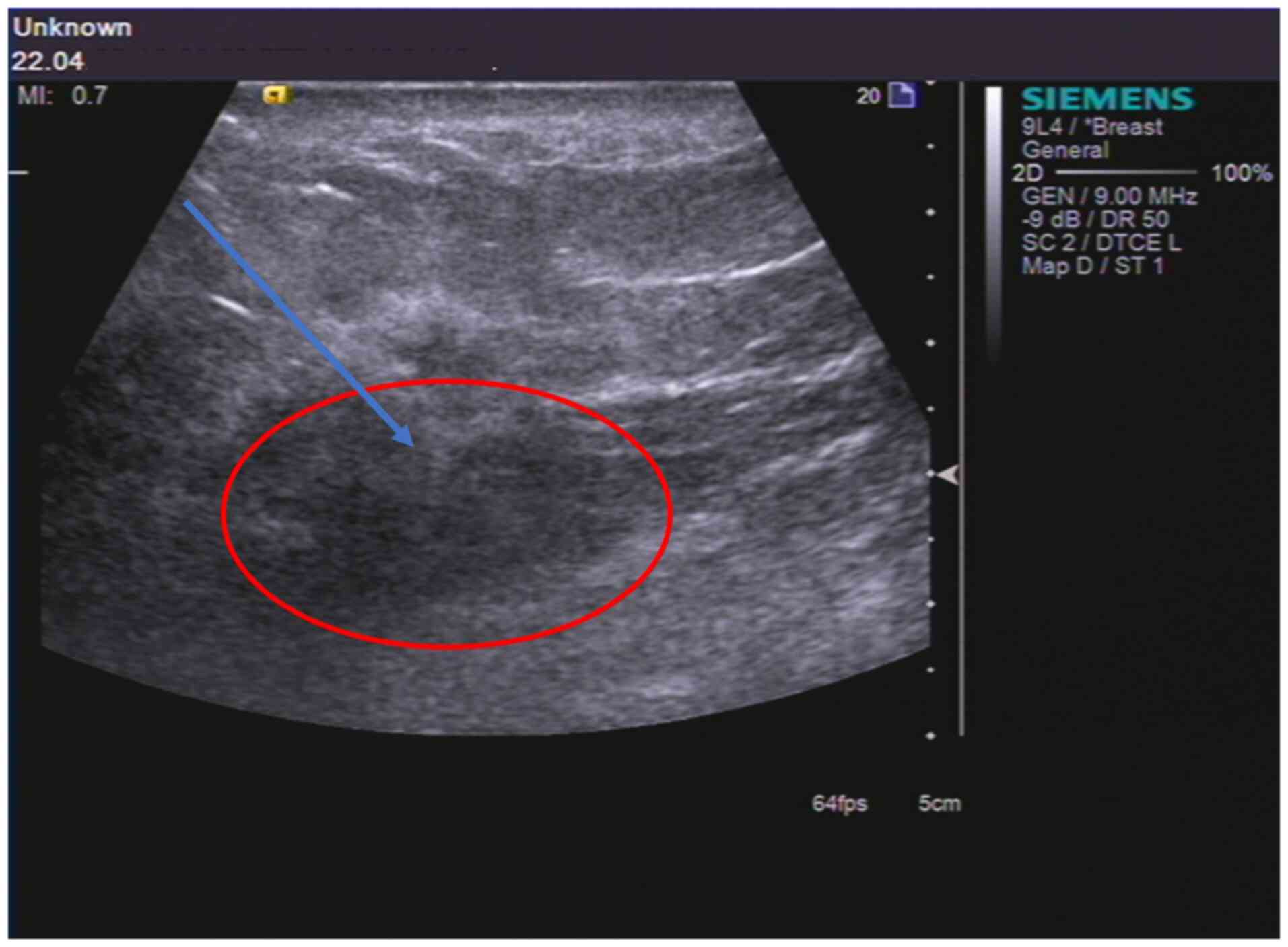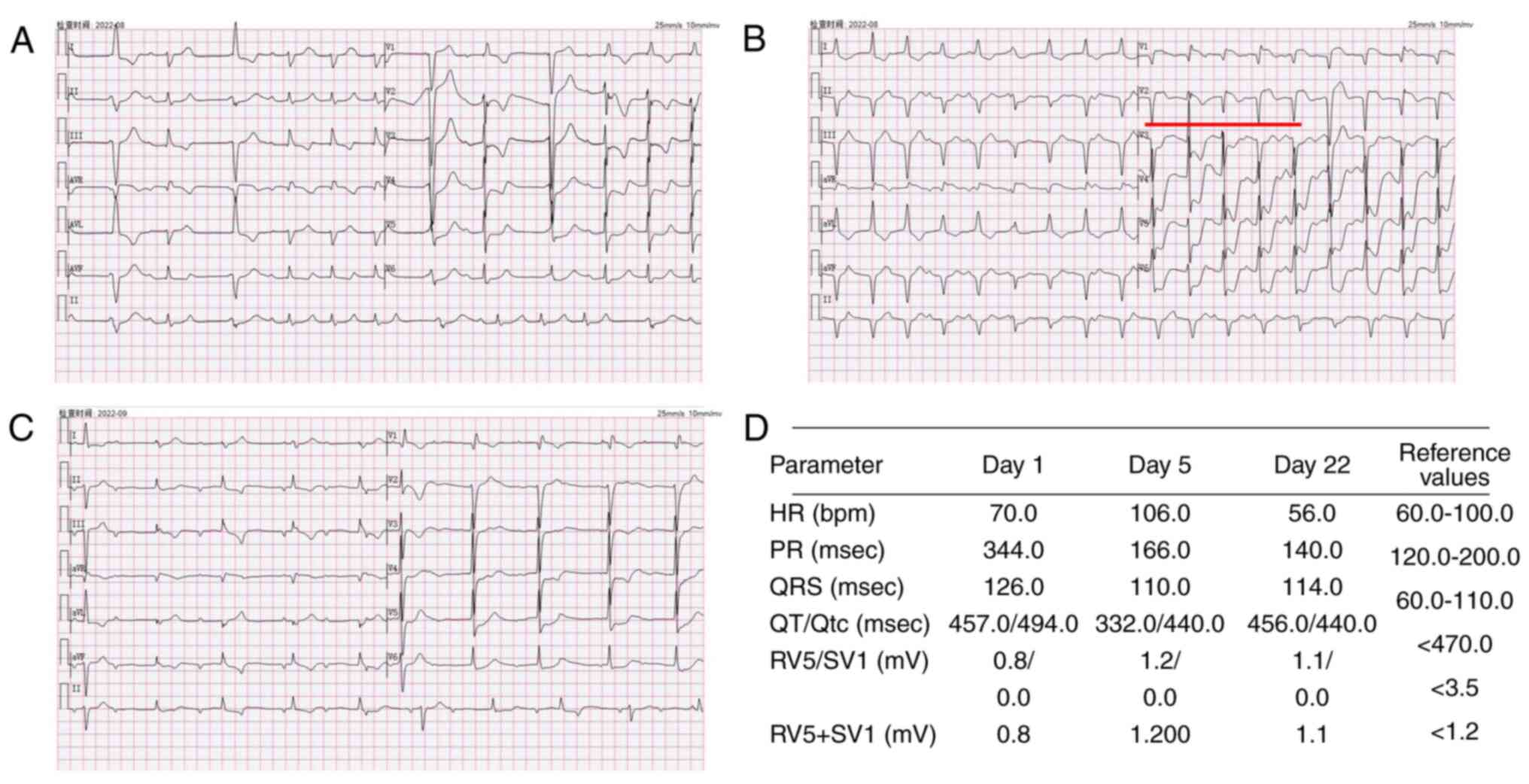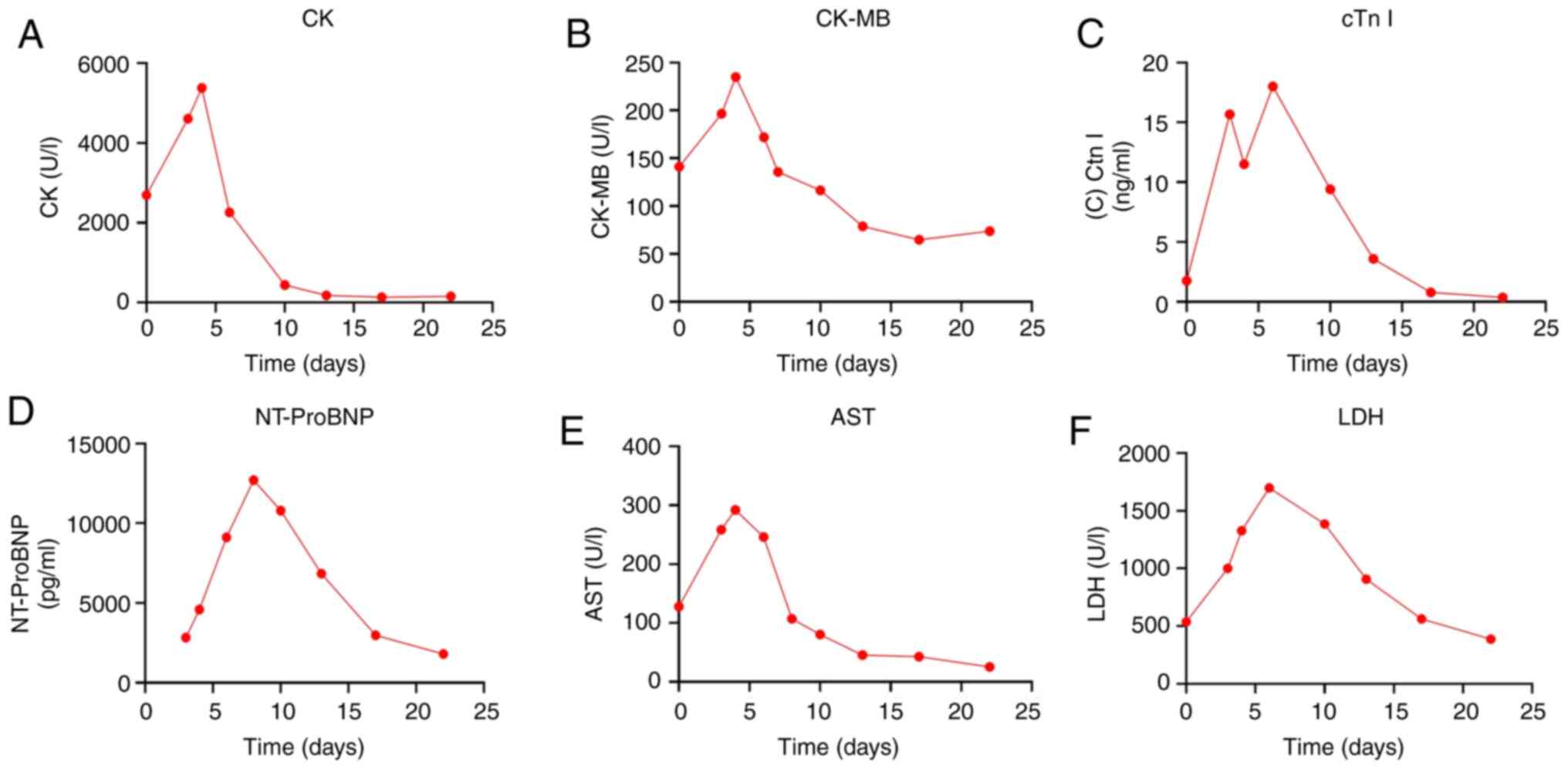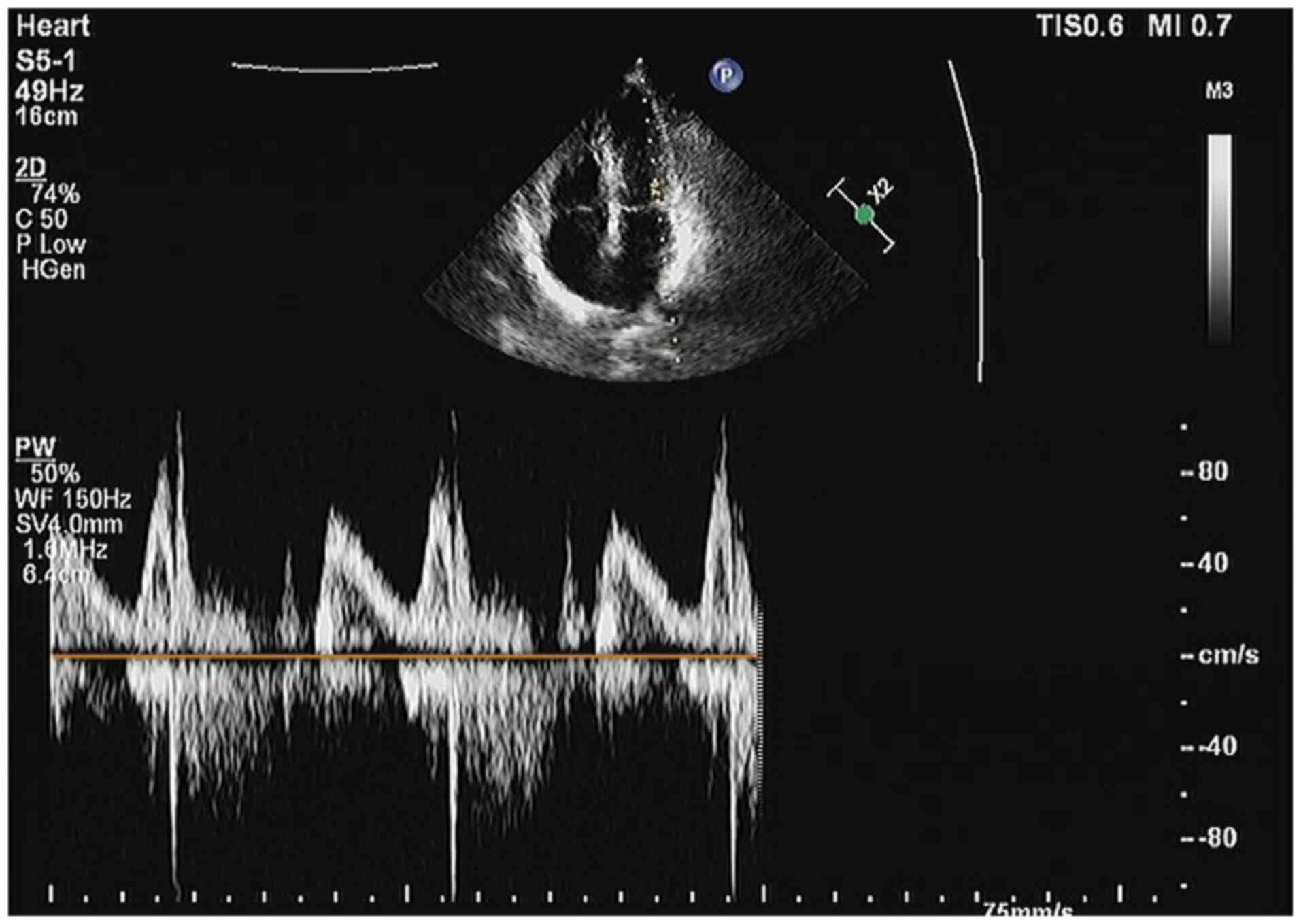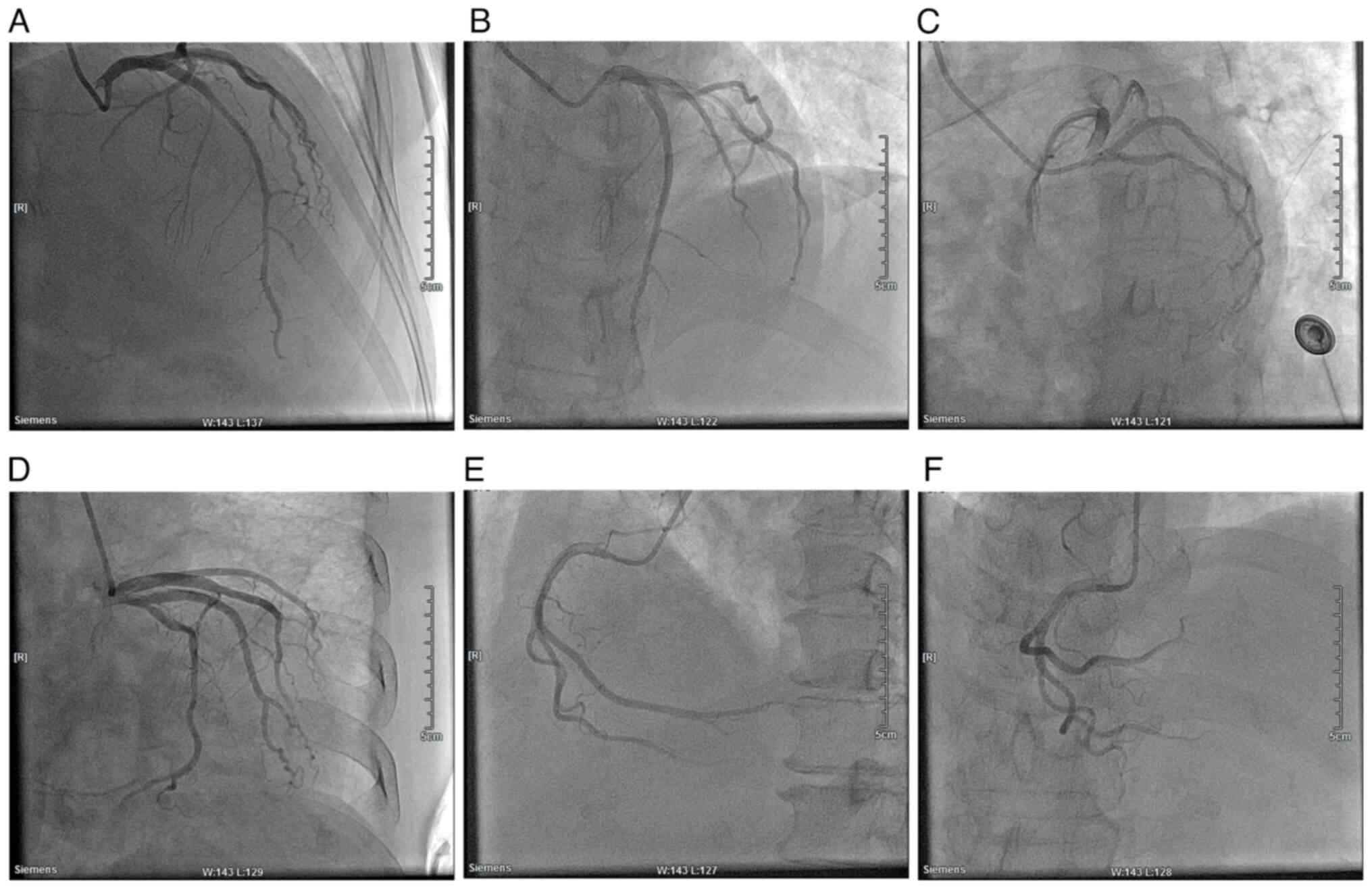Immune myocarditis induced by sintilimab therapy: A case report
- Authors:
- Published online on: June 25, 2024 https://doi.org/10.3892/etm.2024.12622
- Article Number: 333
-
Copyright: © Li et al. This is an open access article distributed under the terms of Creative Commons Attribution License.
Abstract
Introduction
By targeting programmed death receptor 1 (PD-1), programmed cell death ligand 1 (PD-L1) or cytotoxic T-lymphocyte-associated protein 4 (CTLA-4), immune checkpoint inhibitors (ICIs) enhance the cytotoxicity of T cells against tumor cells and prevent their escape, effectively controlling tumor cell proliferation (1-3). Despite the important role of ICIs in tumor therapy, the immune-related adverse events (irAEs) caused by them should not be ignored. During clinical treatment with ICIs, irAEs have been observed in >70% of patients (4-6).
Among all irAEs, ~10% of patients experience cardiovascular-related adverse events. These events can include arrhythmias, pericardial disease, myocarditis and other cardiac symptoms (7,8). One of the most serious conditions is myocarditis, which is frequently triggered by viral infections but is also linked to autoimmune diseases, viral infections, and drug use (9). The use of immune checkpoint inhibitors is a known trigger for myocarditis. Data from VigiBase, the WHO's global international pharmacovigilance database, indicate that the incidence of myocarditis with single ICI treatment is 0.54%, while the incidence of myocarditis with ICI combination therapy is 1.22% (10). The main treatment option for immune checkpoint inhibitor (ICI)-induced myocarditis is immunosuppressive therapy (11). Corticosteroids, cyclosporine, and azathioprine are drugs that have been shown to be effective for myocarditis (12). Glucocorticosteroids, like prednisone, have been proven effective in alleviating immunotherapy-induced myocarditis (13). The current report presents a case with an organized treatment plan of a breast cancer patient who experienced symptoms, such as palpitations and increased cardiac enzyme levels, 1 day after ICI therapy. The patient underwent cardiac angiography to confirm the diagnosis of immune myocarditis and received hormone shock therapy. The present report provides a foundation for the prevention and diagnosis of immune myocarditis caused by ICI therapy.
Case report
In August 2020, a 66-year-old female patient was admitted to Weifang Second People's Hospital (Weifang, China) for a biopsy of a left breast mass to determine the nature of the pathology. The immunohistochemistry results confirmed invasive breast cancer. The patient had type II diabetes but did not have a history of heart disease or any other autoimmune diseases. There was also no previous family history of heart disease or any other autoimmune diseases.
The patient underwent a left breast mass aspiration biopsy in August 2020 under color ultrasound guidance and was assessed at the Weifang Second People's Hospital due to redness and swelling of the left breast mass for 1 month. The patient had been diagnosed with a breast nodule 1 year earlier in Weifang Second People's Hospital (Fig. S1A). The ultrasound results revealed heterogeneous cellular streak-like infiltration in the tissues, with local necrosis observed in the ducts, consistent with the features of invasive breast cancer (Fig. S1B and C). This was further confirmed by magnetic resonance imaging (MRI) and computed tomography (CT) (Fig. S1D-G). The diagnosis of stage III inflammatory breast cancer (T4N0M0) of the left breast was confirmed on the basis of imaging and pathology tests (Fig. 1A) (14). Pathological testing was performed by HE staining, tissues were removed and immediately immersed in 4% PFA for 6 h for fixation at room temperature (RT). After dehydration in a gradient of 70-100% alcohol, it was transparent using xylene and finally embedded in solid paraffin. Tissue wax blocks were finally cut into 4 µm thick sections. After staining with hematoxylin for 7 min at room temperature to show the nuclei, the cytoplasm was stained with eosin for 1 min at room temperature. After gradient dehydration and xylene transparency, the sections were sealed using neutral resin and then visualized using an Olympus orthostatic microscope (Light microscope, objective magnification 10X).
Considering the large size of the tumor in the left breast of the patient, neoadjuvant chemotherapy (epirubicin + paclitaxel regimen, i.v. over a period of 2 days, with 50 mg of epirubicin given on the first day and 120 mg of paclitaxel given on the second day. Dosing was started once 5 days before surgery and once/month after surgery.) was initially administered to shrink the tumor before the patient could undergo radical resection surgery. Briefly, the patient underwent in September 2020 the patient underwent 50 mg (dissolved in 250 ml of saline) of epirubicin intravenous drip chemotherapy. The following day, 120 mg (dissolved in 500 ml saline) paclitaxel IV drip chemotherapy was administered and preoperative preparations were completed, with surgery scheduled for day 4 after the completion of chemotherapy. After 4 days, the patient underwent a modified radical left breast cancer surgery, taking into account the relatively small size of the tumor and its location in a non-central area of the breast. Pathology and immunohistochemistry (IHC) results confirmed a diagnosis of invasive ductal carcinoma, grade II, with metastases found in 28/35 axillary lymph nodes (Figs. 1B and C, and 2A-C), 13 days after admission, the patient was discharged. IHC was performed using paraffin-embedded tissues; briefly, tissues were removed and immediately immersed in 4% PFA for 6 h for fixation (Room temperature, RT). After dehydration in a gradient of 70-100% alcohol, it was transparent using xylene and finally embedded in solid paraffin. Tissue wax blocks were finally cut into 4 µm thick sections. Tissue processing and interpretation of results were performed using Roche's Benchmark GX. EDTAVEGTA pH 8 was selected for antigen repair and was used for repair using machine parameters (100̊C, 30 min). And endogenous catalase was closed with 3% hydrogen peroxide for 5 min (RT). HER2, PR and ER monoclonal antibodies were used to incubate at 37̊C for 30 min (ready-to-use antibody, Maixin, Fuzhou, China, HER2: Kit-0043, 0013; ER: Kit-0012), respectively. Secondary antibodies were incubated with ready-to-use HRP-labeled secondary antibodies from Roche (Roche, Cat. No 760-500) for 8 min at room temperature. This was followed by color development using DAB color solution at room temperature for 8 min (Roche, Cas. No 760-500), and hematoxylin staining was used for 7 min to show the nuclei (RT). After gradient dehydration and xylene transparency, the slices were sealed using neutral resin and observed using an Olympus ortho-microscope (Light microscope, objective magnification 10X). The patient was admitted to the hospital for chemotherapy with a 50 mg (dissolved in 250 ml saline) epirubicin IV drip and a 120 mg (dissolved in 500 ml saline) paclitaxel IV drip regimen the following day, 21 days after left breast surgery (September 2020). The patient received chemotherapy on day 54 (October 2020), day 80 (November 2020), day 107 (December 2020), day 134 (January 2021) and day 162 (February 2021). Chemotherapy was administered according to the same regimen for a total of 6 cycles. At 187 days postoperatively (March 2021) the patient was readmitted to the hospital and discharged after receiving 5 days of adaptive intensity-modulated radiotherapy to the axillary region of the left breast. This treatment was administered after consultation with a radiologist, who determined that the patient met the criteria for radiotherapy. After surgical treatment, the patient experienced a progression-free survival of ~2 years.
A total of 2 years after the radical resection surgery, in April 2022, the patient was admitted to the Weifang Second People's Hospital after experiencing redness and swelling of the right breast mass for 1 month. Considering the medical history of the patient, an ultrasound-guided aspiration biopsy of the right breast mass was performed (Fig. 3). The pathology results revealed stage III inflammatory breast carcinoma (T4N0M1) in the right breast (Fig. 1D). The patient was treated with chemotherapy (preoperative chemotherapy twice, postoperative chemotherapy once a month) using an IV drip regimen of epirubicin (80 mg dissolved in 250 ml saline) + paclitaxel (120 mg dissolved in 500 ml saline). The patient received two rounds of chemotherapy in April and May, respectively, and underwent a modified radical surgery for right breast cancer 20 days after the end of chemotherapy in May. In May 2022, the updated pathology report of the right breast revealed grade III invasive carcinoma, with visible vascular embolus and nerve invasion. No cancerous tissues were found in the nipple or the base margin. Carcinoma metastasis was identified in all 23 axillary lymph nodes and in all 3 of the other lymph nodes assessed (Figs. 1E and F, and 2D-F). CT scan showed multiple microscopic nodules in the lung, which raised concerns about metastatic tumors (Fig. S2A). The patient was discharged from the hospital 14 days after undergoing surgery on the right breast and following chemotherapy treatment with an epirubicin (90 mg dissolved in 250 ml saline) + cyclic AMP (0.8 g). The chemotherapy was administered intravenous injection for 2 days, with epirubicin injected on the first day and cyclophosphamide on the second day, administered once a month.
A total of 34 days after the right breast surgery (June 2022), a CT review revealed multiple microscopic nodules in both lungs and MRI demonstrated possible secondary metastases in the lumbosacral spine (Fig. S2B and C). In conjunction with the self-reported pain of the patient, zoledronic acid (4 mg in 100 ml saline intravenous injection) was administered to alleviate the pain from the bone metastasis. Additionally, chemotherapy with an epirubicin (90 mg dissolved in 250 ml saline) + cyclic AMP (0.8 g dissolved in 250 ml saline) regimen was initiated 1 day after admission (July 2022). A total of 60 days after the right breast surgery (July 2022), chemotherapy with epirubicin (90 mg dissolved in 250 ml saline) + cyclic AMP (0.8 g dissolved in 250 ml saline) regimen was administered.
The patient was admitted again in August 2022 for the fourth time post- right breast surgery (The date of the patient's current admission was noted as Day 0), and the patient denied any recent gastrointestinal illness before admission. On admission, the temperature of patient was 36.5˚C, heart rate was 70 beats/min, respiratory rate was 20 per min, and blood pressure was 139/78 mmHg. The patient presented with a cough and wheezing, and a complete chest CT was performed to assess any postradiotherapy changes in the left lung (Fig. S2D). Additionally, nasopharyngeal swabs were taken and tested negative for coronavirus disease 2019 (COVID-19). The patient was initially diagnosed with secondary malignant tumors in both lungs, secondary metastases in the ribs and secondary metastases in the lumbosacral spine based on the lumbar spine MRI and thoracic spiral CT scans.
The patient was treated with antitumor immunotherapy with an IV drip of sintilimab (self-contained; cat. no. Innovent Co. Suzhou China; DP2201036; 200 mg dissolved in 100 ml saline). The patient experienced panic and palpitations. Although the patient developed this irAE within 1 day of administration, the symptoms did not develop within 1-3 h of the start of the infusion, which indicated that it was not an infusion reaction. In Day 6, Creatine kinase (CK) was 2263.2 U/l (reference values, 40-200 U/l), cardiac troponin I (cTn I) was 18.01 ng/ml (reference values, 0-0.028 ng/ml), CK-isoenzymes (CK-MB) was 172 U/l (reference values, 0-20 U/l) and N-terminal pro-brain natriuretic peptide was 9,121 pg/ml (reference values, 0-300 pg/ml), as presented in Table I, indication of changes in cardiac enzyme profiles. An electrocardiogram (Fig. 4) revealed sinus rhythm, first-degree atrioventricular block, complete right bundle branch block, frequent premature ventricular contractions and myocardial ischemia. Acute coronary syndrome or immune-related myocarditis was considered. After transfer to the cardiology department, a review of the myocardial enzyme profile was performed (Fig. 5). The N-terminal brain-lysergic peptide precursor was detected, and all the indices were elevated compared with Day 0. This led to a preliminary diagnosis of acute coronary syndrome and was treated with 0.5 g methylprednisolone (IV) to prevent further deterioration of the patient condition. Coronary angiography combined with stenting was proposed on Day 4 to determine the cause of the patient's condition. A cardiac ultrasound determined that the patient did not have a medically significant myocardial infarction (Fig. 6). Cardiac angiography showed that there was no stenosis in the left main stem, 40% stenosis in the middle of the left anterior descending branch, and no significant stenosis in the echogenic branch (Fig. 7). The right crown was thick and smooth with no narrowing. Based on the results of the electrocardiogram, cardiac enzyme levels and a history of immunosuppressant medication, immune myocarditis was considered. The patient was treated with hormone shock therapy (methylprednisolone sodium succinate, 0.5 g dissolved in 100 ml saline IV drip) specifically for this condition, which was supplemented with pro-immunoglobulin (10 g daily by intravenous injection until Day 11). As a result, the cTn I level decreased to 11.5 pg/ml (reference values, 0-300 pg/ml). On Day 6, paroxysmal ventricular tachycardia was observed on monitoring. The electrocardiogram indicated frequent ventricular premature beats and a high risk of sudden cardiac death due to cardiac arrest (Fig. 4B marked with red line). Therefore, the patient was immediately placed on a single dose of hormonal therapy with a single dose of the antiarrhythmic drug esmolol administered intravenously along with 0.5 g methylprednisolone, a hormonal shock treatment drug. The cardiac enzyme spectra review on Day 10 demonstrated that the patient's CK-MB levels had decreased compared with the previous test (116.6 U/l; reference values, 0-20 U/l), which suggested an improvement in myocardial damage. Maintenance of hormone shock therapy and regular review of the myocardial enzyme spectrum were performed until Day 22. The cardiac enzyme markers improved significantly, indicating a good treatment response. The patient's general condition was stabilized and the level of care was changed from level 1 to level 2, and the patient was observed every two hours for changes in condition and vital signs. A new coronary nucleic acid test was negative. It was agreed that the patient could be discharged. The patient was discharged from the hospital on Day 22 and after discharge the patient took the medicine of Spironolactone (20 mg), tachycardia (20 mg) and potassium chloride extended-release tablets (0.5 g) were administered to enhance the cardiac function of the patient and to regulate blood potassium levels. Hormonal therapy was continued until the patient was discharged from the hospital after 10 days. The patient received 20 mg/day prednisone acetate tablets in the morning from Days 1 to 5, which was then reduced to 10 mg/day after Day 5 and discontinued on Day 10. It was suggested that the patient should improve their lifestyle after hospitalization, including paying attention to rest, avoiding exertion and emotional excitement, taking medication on time, coming to the hospital regularly for review, and promptly consulting a doctor if they felt unwell. One month after discharged from the hospital, the patient was followed up by telephone and there was no recurrence of myocarditis or other specific conditions such as chest tightness and palpitations.
Discussion
Myocarditis is the clinical and histologic manifestation of a widespread pathologic immune process in the heart, which is divided into acute myocarditis and chronic myocarditis (15). The common causes of myocarditis include viral infections or immune responses to viral infections (16). The wide range of clinical manifestations makes the diagnosis of the disease challenging. An attack of myocarditis is typically characterized by the acute onset of chest pain, dyspnea and palpitations (17). The diagnosis of acute myocarditis is typically made by considering clinical symptoms, electrocardiographic findings, echocardiographic results and troponin levels; however, the gold standard for confirming the diagnosis and distinguishing it from other conditions is an endomyocardial myocardial biopsy, despite its limitations due to the invasive nature of the procedure (18). Here, the patient developed symptoms related to myocarditis at an early stage and was treated appropriately, which can provide a clinical reference for the use of chemotherapeutic agents in the PD-1 class resulting in myocarditis.
Worldwide, viral infections are the most common cause of myocarditis, the incidence of myocarditis is estimated to be about 10 to 22 cases per 100,000 people (19). Although myocarditis caused by other factors is less common, it still requires attention. For example, myocarditis caused by autoimmune diseases, such as systemic lupus erythematosus, accounts for ~7% of patients with myocarditis (20). Additionally, drug-induced myocarditis primarily occurs in patients who are vaccinated, particularly following smallpox vaccination, with 13.2 cases per 100,000 doses. Following COVID-19 vaccination, the median incidence was 1.9 cases per 100,000 people for the first two doses of the BNT162b2 vaccine and 3.5 cases for the mRNA-1273 vaccine. Influenza vaccination had an incidence of 0.13 cases per 100,000 doses, while other non-smallpox vaccines had an incidence of 5.7 cases per 100,000 doses (21).
The patient in the present study developed palpitations after treatment with Sintilimab. Myocardial enzyme profiling revealed increased levels of markers of myocardial injury, and cardiography indicated no significant stenotic lesions. Considering the temporal association between the administration of the ICI and the onset of clinical symptoms, as well as the exclusion of other potential causes (such as normal coronary arteries, no history of rheumatoid virus infections, no chronic medications that could be linked to myocarditis, no history of autoimmune disease and negative swabs for COVID-19 infection), it was determined that the patient experienced immune myocarditis caused by ICIs.
ICIs are commonly used as the initial treatment for numerous types of cancer. These inhibitors work by blocking either CTLA-4 or PD-1, which helps to reactivate the T-cells and enhance their ability to eliminate tumors (22-24). Sintilizumab is a recombinant, fully human IgG4-type anti-PD-1 monoclonal antibody that blocks the interaction between PD-1 and its ligands, thereby helping T cells to regain their anti-tumor effects (25-27). Typically, the heart is susceptible to immune-mediated injury due to its dense vascular system providing access to immune cells and antibodies. Normally, the presence of cardiomyocytes, including Th1 cells that secrete the cytokine IFN-γ, causes cardiac endothelial cells to upregulate PD-L1 to suppress effector T cells. Sintilimab was able to block the interaction between PD-1 and its ligand, which may lead to effector T cell attack on cardiac endothelial cells (28). According to its antitumor mechanism, this drug may cause irAEs.
Immune myocarditis is a rare but highly lethal complication, and the mechanism underlying this condition has not yet been fully elucidated, the incidence ranges from 0.06% in patients treated with single-agent anti-PD-1 therapy to 0.27% in patients treated with a combination of anti-CTLA-4 and anti-PD-1 therapy (29). A retrospective analysis of the World Health Organization Pharmacovigilance Database revealed that immune-associated myocarditis had the highest mortality rate among all immune-related adverse events (irAEs), with fatalities reported in ~ 40% of the 131 cases (30); however, previous studies have reported that the presence of high-frequency T-cell receptor sequences in cardiomyocytes suggests that they may share targets with tumor cells (31,32). Animal model studies have reported that CTLA-4, PD-1 and PD-L1 have cardioprotective effects against immune-mediated injury following stress (28,33,34). This suggests a potential mechanism for the development of myocarditis in ICIs. However, since the median time to onset of immune myocarditis due to ICIs is 34 days after initiation of ICI therapy, early symptoms can be easily dismissed as other cardiovascular diseases, leading to delayed treatment (29).
The present study reports a case of immune myocarditis induced by ICIs. The cardiac enzyme profiles throughout the course of the disease were recorded and detailed. Although the incidence of immune myocarditis due to ICIs is relatively low (about 0.06-0.27%), the median time of onset of the disease is typically ~1 month after starting ICI therapy (35). However, in the present study, the patient developed palpitations 2 days after receiving the drug. Additionally, there was a marked increase in the levels of cardiac enzyme-related markers within a short period of time. It was hypothesize that this phenomenon could be due to several reasons: First, the patient had diabetes mellitus. A retrospective study by Mahmood et al (36),found that a higher proportion of patients who developed myocarditis had a higher prevalence of diabetes mellitus (both type I and type II) compared with those who did not, suggesting that diabetes mellitus may be an unfavorable factor for the elicitation of myocarditis while undergoing ICIs (37). Second, the patient received the EC-T regimen (Epirubicin, Cyclophosphamide and Paclitaxel) of chemotherapy before ICIs. The cardiotoxicity of epirubicin accumulated and resulted in a notable increase in cardioactive enzymes in the patient prior to treatment with ICIs. Certain patients may exhibit myocardial damage prior to treatment with ICIs, which could also contribute to the early onset of immune myocarditis (38). Notably, when considering myocarditis caused by ICIs, it is important to also consider other potential diagnoses, which may include acute coronary syndrome, stress cardiomyopathy and viral myocarditis. These conditions can be challenging to accurately diagnose based solely on clinical presentation (39-41). Comprehensive coronary CT angiography, invasive coronary angiography, electrocardiogram, infection indicators and patient history can help clinicians make a differential diagnosis.
Finally, there are certain limitations in the present study. Detection of anti-myosin antibodies and anti-cardiac troponin antibodies by flow cytometry could have provided more accurate data to help clinicians make a diagnosis; however, the Weifang Second People's Hospital did not have this kind of testing equipment to carry out anti-myosin antibody and anti-cardiac troponin antibody testing, and there was insufficient time to send patient samples to a third-party testing organization with relevant capabilities for testing or to carry out this kind of testing, due to the patient's condition deteriorating rapidly and the need to carry out rescue as soon as possible. There was also insufficient time to send samples to a competent third-party testing organization for testing.
In summary, although immune myocarditis is a rare side effect of ICI therapy and has a delayed onset, it is important to closely monitor patients for any signs of myocarditis. Additionally, timely detection of myocardial enzyme profiles should be performed after the drug is administered clinically. For patients with underlying medical conditions such as diabetes mellitus, and patients who have received chemotherapy using anthracyclines prior to dosing, it may be advisable to administer a specific dosage of hormones beforehand to mitigate potential adverse effects, if deemed necessary.
Supplementary Material
Color chest ultrasound, MRI and CT scan images. The areas circled in red are suspected tumor areas). Color chest ultrasound of the (A) left intramammary nodule, (B) Pre-operative changes in the left breast and (C) left breast lesion. (D) MIR images of the breast (E) Magnetic resonance dynamic enhancement silhouette of the patient. (F) Magnetic resonance dynamic enhancement time-one signal intensity curves in patients. (G) Chest CT scan. MRI, magnetic resonance imaging; CT, computed tomography.
Chest CT and MRI results. (A) Multiple microscopic nodules in the lungs. (B) Review of multiple microscopic nodules in the lungs. (C) Lumbar spine MRI. (D) Chest CT. Nodes circled in red are suspected secondary metastases. MRI, magnetic resonance imaging; CT, computed tomography.
Acknowledgements
Not applicable.
Funding
Funding: The present study was supported by the Shandong Province School Health Association (grant no. SDWS2023179).
Availability of data and materials
The data generated in the present study may be requested from the corresponding author.
Authors' contributions
YL was the primary care physician of the patient and developed and implemented the treatment plan. YW and BW performed the literature review and analyzed and interpreted the data in the paper. BZ and BY organized the patient's treatment process and analysis of the data. MQ and YT drafted the work and critically revised important intellectual content. MQ and YT confirm the authenticity of all the raw data MQ completed immunohistochemical examination and imaging analysis. YT performed the histological examination of the tumor and wrote the manuscript. All authors commented on the manuscript and agreed with the conclusions of the manuscript. All authors have read and approved the final manuscript.
Ethics approval and consent to participate
This study was reviewed by the Ethics Committee of the Weifang Second People's Hospital (approval no. YX2020-001-01) and was performed in accordance with the Declaration of Helsinki.
Patient consent for publication
The patient provided written informed consent for the publication of the manuscript including any identifying images or data.
Competing interests
The authors declare that they have no competing interests.
Use of artificial intelligence tools
During the preparation of this work, artificial intelligence tools were used to improve the readability and language of the manuscript or to generate images, and subsequently, the authors revised and edited the content produced by the artificial intelligence tools as necessary, taking full responsibility for the ultimate content of the present manuscript.
References
|
Chen W, Huang Y, Pan W, Xu M and Chen L: Strategies for developing PD-1 inhibitors and future directions. Biochem Pharmacol. 202(115113)2022.PubMed/NCBI View Article : Google Scholar | |
|
Yi M, Zheng X, Niu M, Zhu S, Ge H and Wu K: Combination strategies with PD-1/PD-L1 blockade: Current advances and future directions. Mol Cancer. 21(28)2022.PubMed/NCBI View Article : Google Scholar | |
|
Ghahremani Dehbokri S, Alizadeh N, Isazadeh A, Baghbanzadeh A, Abbaspour-Ravasjani S, Hajiasgharzadeh K and Baradaran B: CTLA-4: As an immunosuppressive immune checkpoint in breast cancer. Curr Mol Med. 23:521–526. 2023.PubMed/NCBI View Article : Google Scholar | |
|
Chennamadhavuni A, Abushahin L, Jin N, Presley CJ and Manne A: Risk factors and biomarkers for immune-related adverse events: A practical guide to identifying high-risk patients and rechallenging immune checkpoint inhibitors. Front Immunol. 13(779691)2022.PubMed/NCBI View Article : Google Scholar | |
|
Darnell EP, Mooradian MJ, Baruch EN, Yilmaz M and Reynolds KL: Immune-related adverse events (irAEs): Diagnosis, management, and clinical pearls. Curr Oncol Rep. 22(39)2020.PubMed/NCBI View Article : Google Scholar | |
|
Das S and Johnson DB: Immune-related adverse events and anti-tumor efficacy of immune checkpoint inhibitors. J Immunother Cancer. 7(306)2019.PubMed/NCBI View Article : Google Scholar | |
|
Cozma A, Sporis ND, Lazar AL, Buruiana A, Ganea AM, Malinescu TV, Berechet BM, Fodor A, Sitar-Taut AV, Vlad VC, et al: Cardiac toxicity associated with immune checkpoint inhibitors: A systematic review. Int J Mol Sci. 23(10948)2022.PubMed/NCBI View Article : Google Scholar | |
|
Dolladille C, Ederhy S, Sassier M, Cautela J, Thuny F, Cohen AA, Fedrizzi S, Chrétien B, Da-Silva A, Plane AF, et al: Immune checkpoint inhibitor rechallenge after immune-related adverse events in patients with cancer. JAMA Oncol. 6:865–871. 2020.PubMed/NCBI View Article : Google Scholar | |
|
Salvi A, Di Lenarda A, Dreas L, Silvestri F and Camerini F: Immunosuppressive treatment in myocarditis. Int J Cardiol. 22:329–338. 1989.PubMed/NCBI View Article : Google Scholar | |
|
Rubio-Infante N, Ramirez-Flores YA, Castillo EC, Lozano O, Garcia-Rivas G and Torre-Amione G: A systematic review of the mechanisms involved in immune checkpoint inhibitors cardiotoxicity and challenges to improve clinical safety. Front Cell Dev Biol. 10(851032)2022.PubMed/NCBI View Article : Google Scholar | |
|
Cooper LT Jr, Berry GJ and Shabetai R: Idiopathic giant-cell myocarditis-natural history and treatment. Multicenter giant cell myocarditis study group investigators. N Engl J Med. 336:1860–1866. 1997.PubMed/NCBI View Article : Google Scholar | |
|
Moslehi J, Lichtman AH, Sharpe AH, Galluzzi L and Kitsis RN: Immune checkpoint inhibitor-associated myocarditis: Manifestations and mechanisms. J Clin Invest. 131(e145186)2021.PubMed/NCBI View Article : Google Scholar | |
|
Norwood TG, Westbrook BC, Johnson DB, Litovsky SH, Terry NL, McKee SB, Gertler AS, Moslehi JJ and Conry RM: Smoldering myocarditis following immune checkpoint blockade. J Immunother Cancer. 5(91)2017.PubMed/NCBI View Article : Google Scholar | |
|
Giuliano AE, Edge SB and Hortobagyi GN: Eighth edition of the AJCC cancer staging manual: Breast cancer. Ann Surg Oncol. 25:1783–1785. 2018.PubMed/NCBI View Article : Google Scholar | |
|
Ammirati E and Moslehi JJ: Diagnosis and treatment of acute myocarditis: A review. JAMA. 329:1098–1113. 2023.PubMed/NCBI View Article : Google Scholar | |
|
Matsumori A: Myocarditis and autoimmunity. Expert Rev Cardiovasc Ther. 21:437–451. 2023.PubMed/NCBI View Article : Google Scholar | |
|
Cooper LT Jr: Myocarditis. N Engl J Med. 360:1526–1538. 2009.PubMed/NCBI View Article : Google Scholar | |
|
Lampejo T, Durkin SM, Bhatt N and Guttmann O: Acute myocarditis: Aetiology, diagnosis and management. Clin Med (Lond). 21:e505–e510. 2021.PubMed/NCBI View Article : Google Scholar | |
|
Olejniczak M, Schwartz M, Webber E, Shaffer A and Perry TE: Viral myocarditis-incidence, diagnosis and management. J Cardiothorac Vasc Anesth. 34:1591–1601. 2020.PubMed/NCBI View Article : Google Scholar | |
|
Rose NR: Myocarditis: Infection versus autoimmunity. J Clin Immunol. 29:730–737. 2009.PubMed/NCBI View Article : Google Scholar | |
|
Ling RR, Ramanathan K, Tan FL, Tai BC, Somani J, Fisher D and MacLaren G: Myopericarditis following COVID-19 vaccination and non-COVID-19 vaccination: A systematic review and meta-analysis. Lancet Respir Med. 10:679–688. 2022.PubMed/NCBI View Article : Google Scholar | |
|
Kgokolo MCM, Anderson K, Siwele SC, Steel HC, Kwofie LLI, Sathekge MM, Meyer PWA, Rapoport BL and Anderson R: Elevated levels of soluble CTLA-4, PD-1, PD-L1, LAG-3 and TIM-3 and systemic inflammatory stress as potential contributors to immune suppression and generalized tumorigenesis in a cohort of South African xeroderma pigmentosum patients. Front Oncol. 12(819790)2022.PubMed/NCBI View Article : Google Scholar | |
|
Im E, Sim DY, Lee HJ, Park JE, Park WY, Ko S, Kim B, Shim BS and Kim SH: Immune functions as a ligand or a receptor, cancer prognosis potential, clinical implication of VISTA in cancer immunotherapy. Semin Cancer Biol. 86:1066–1075. 2022.PubMed/NCBI View Article : Google Scholar | |
|
Zhou X, Khan S, Huang D and Li L: V-Set and immunoglobulin domain containing (VSIG) proteins as emerging immune checkpoint targets for cancer immunotherapy. Front Immunol. 13(938470)2022.PubMed/NCBI View Article : Google Scholar | |
|
Dall'Olio FG, Marabelle A, Caramella C, Garcia C, Aldea M, Chaput N, Robert C and Besse B: Tumour burden and efficacy of immune-checkpoint inhibitors. Nat Rev Clin Oncol. 19:75–90. 2021.PubMed/NCBI View Article : Google Scholar | |
|
Zhang L, Mai W, Jiang W and Geng Q: Sintilimab: A promising anti-tumor PD-1 antibody. Front Oncol. 10(594558)2020.PubMed/NCBI View Article : Google Scholar | |
|
Hoy SM: Sintilimab: First global approval. Drugs. 79:341–346. 2019.PubMed/NCBI View Article : Google Scholar | |
|
Grabie N, Gotsman I, DaCosta R, Pang H, Stavrakis G, Butte MJ, Keir ME, Freeman GJ, Sharpe AH and Lichtman AH: Endothelial programmed death-1 ligand 1 (PD-L1) regulates CD8 + T-cell-mediated injury in the heart. Circulation. 116:2062–2071. 2007.PubMed/NCBI View Article : Google Scholar | |
|
Inno A, Tarantini L, Parrini I, Spallarossa P, Maurea N, Bisceglia I, Silvestris N, Russo A and Gori S: Cardiovascular effects of immune checkpoint inhibitors: More than just myocarditis. Curr Oncol Rep. 25:743–751. 2023.PubMed/NCBI View Article : Google Scholar | |
|
Wang DY, Salem JE, Cohen JV, Chandra S, Menzer C, Ye F, Zhao S, Das S, Beckermann KE, Ha L, et al: Fatal toxic effects associated with immune checkpoint inhibitors: A systematic review and meta-analysis. JAMA Oncol. 4:1721–1728. 2018.PubMed/NCBI View Article : Google Scholar | |
|
Johnson DB, Balko JM, Compton ML, Chalkias S, Gorham J, Xu Y, Hicks M, Puzanov I, Alexander MR, Bloomer TL, et al: Fulminant myocarditis with combination immune checkpoint blockade. N Engl J Med. 375:1749–1755. 2016.PubMed/NCBI View Article : Google Scholar | |
|
Reuben A, Petaccia de Macedo M, McQuade J, Joon A, Ren Z, Calderone T, Conner B, Wani K, Cooper ZA, Tawbi H, et al: Comparative immunologic characterization of autoimmune giant cell myocarditis with ipilimumab. Oncoimmunology. 6(e1361097)2017.PubMed/NCBI View Article : Google Scholar | |
|
Grabie N, Lichtman AH and Padera R: T cell checkpoint regulators in the heart. Cardiovasc Res. 115:869–877. 2019.PubMed/NCBI View Article : Google Scholar | |
|
Ise W, Kohyama M, Nutsch KM, Lee HM, Suri A, Unanue ER, Murphy TL and Murphy KM: CTLA-4 suppresses the pathogenicity of self antigen-specific T cells by cell-intrinsic and cell-extrinsic mechanisms. Nat Immunol. 11:129–135. 2010.PubMed/NCBI View Article : Google Scholar | |
|
Zhang C, Qin S and Zuo Z: Immune-related myocarditis in two patients receiving camrelizumab therapy and document analysis. J Oncol Pharm Pract. 28:1350–1356. 2022.PubMed/NCBI View Article : Google Scholar | |
|
Mahmood SS, Fradley MG, Cohen JV, Nohria A, Reynolds KL, Heinzerling LM, Sullivan RJ, Damrongwatanasuk R, Chen CL, Gupta D, et al: Myocarditis in patients treated with immune checkpoint inhibitors. J Am Coll Cardiol. 71:1755–1764. 2018.PubMed/NCBI View Article : Google Scholar | |
|
Varricchi G, Galdiero MR, Marone G, Criscuolo G, Triassi M, Bonaduce D, Marone G and Tocchetti CG: Cardiotoxicity of immune checkpoint inhibitors. ESMO Open. 2(e000247)2017.PubMed/NCBI View Article : Google Scholar | |
|
Lee SH, Cho I, You SC, Cha MJ, Chang JS, Kim WD, Go KY, Kim DY, Seo J, Shim CY, et al: Cancer therapy-related cardiac dysfunction in patients treated with a combination of an immune checkpoint inhibitor and doxorubicin. Cancers (Basel). 14(2320)2022.PubMed/NCBI View Article : Google Scholar | |
|
Wieczorkiewicz P, Supel K, Przybylak K, Kacprzak M and Zielinska M: Acute coronary syndrome versus acute myocarditis in young adults-value of speckle tracking echocardiography. PLoS One. 17(e0271483)2022.PubMed/NCBI View Article : Google Scholar | |
|
Canan A, Van Woerkom RC and Rajiah PS: Myocarditis mimicking stress-induced (takotsubo) cardiomyopathy. Tex Heart Inst J. 49(e207430)2022.PubMed/NCBI View Article : Google Scholar | |
|
Pollack A, Kontorovich AR, Fuster V and Dec GW: Viral myocarditis-diagnosis, treatment options, and current controversies. Nat Rev Cardiol. 12:670–680. 2015.PubMed/NCBI View Article : Google Scholar |



